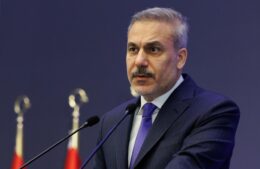Welcome to «Erdoganstan»: Bosna Hersek to Mongolistan
- (0)
Welcome to «Erdoganstan»: Bosna Hersek to Mongolistan –

By Wayne Madsen
Strategic Culture
When Turkish President Recep Tayyip Erdogan’s Justice and Development Party (AKP) first gained power in the parliamentary election of 2002, commentators foresaw a Turkey that would, while stressing some Islamist principles, remain a secular nation that would not interfere in the affairs of its closest neighbors and distant countries.
It was not long before the secularist Republican People’s Party (CHP) that championed the non-Islamist guidance of Turkey’s founder, Kemal Ataturk, were able to point to the pan-Islamist and pan-Turkic policies of then-Prime Minister Erdogan’s government and say to those who originally bought into the AKP propaganda, «We told you so!»
There is a reason why Erdogan built for himself a palatial presidential palace in Ankara that evokes memories of the Seljuk Empire. Erdogan, who castigated the Ataturk hero-worship policies of the opposition CHP, has created his own cult of personality, one that advances a political philosophy that combines Islamist beliefs and Ottoman hegemony with Turanism.
When the AKP first came to power in Turkey, its government stated that Turkey would establish close relations with all nations, near and far. What it did not say was that this new international policy was aimed at forging close relations with the Wahhabist regimes of Saudi Arabia and the Gulf to depose secularist Arab socialist-based governments in Syria, Libya, Egypt, and Tunisia. Soon, Turkish arms were flowing to Islamist rebel groups composed of both pro-Saudi Salafists and pro-Qatari Muslim Brotherhood members in Syria and Libya. Both nations experienced «Arab Spring» revolutions egged on by George Soros’s social media operatives under the umbrella of the Open Society Institute and the National Endowment for Democracy (NED).
Erdogan’s envoys were also working closely with the Ennahda Movement in Tunisia and the Freedom and Justice Party of Egypt, both of which took their inspiration from the AKP and the Muslim Brotherhood. After taking power in Tunisia and Egypt, Turkey’s political offspring in Tunisia and Egypt, Presidents Moncef Marzouki and Mohamed Morsi, respectively, announced their support for the Islamist rebels in the Libyan and Syrian civil wars. Behind the scenes was Erdogan who President Barack Obama praised as a Muslim leader with whom the United States relied on for its «outreach» to the Muslim world.
However, Erdogan’s new international «outreach» is not limited to his Arab south. Advancing the pan-Turanian concept, which includes pan-Turkic notions in addition to the idea that the Uralo-Altaic peoples constitute a distinct «Turanid» race, Erdogan has set course to include peoples stretching from Bosnia-Herzegovina (Bosna Hersek) in the Balkans to Japan in the Far East in a Turanian «commonwealth» of nations. Not only has Erdogan sat idly by while hundreds of thousands of Syrian, Iraqi, and Afghan migrants transited through Turkey to overwhelm Europe in a virtual Muslim invasion not seen since the Ottoman siege of Vienna of 1529 but his intelligence service, the «Millî İstihbarat Teşkilatı», or MIT, as facilitated the recruitment into the ranks of the Islamic State of Iraq and the Levant (ISIL), the Nusra Front, Al Qaeda, and the Khorasan Group of Muslim mercenaries from the claimed pan-Turanian lands of Chechnya (called Chechenistan by the Turks), Uzbekistan, Tajikistan, western China («East Turkestan»), and Afghanistan.
Opposing these mercenaries are those who would suffer the most under Erdogan’s concept of a new Ottoman-Seljuk Empire that would treat Muslim and Christian Kurds, Alawites, Shi’as, Armenians, Greeks, Maronite Christians, Russians, Ukrainians, Chinese, and others not recognized as full equals in an Ottoman-Seljuk Sunni Muslim/Turanian empire as second-class citizens and infidels.
In the minds of the pan-Turanians, any race not descended from the ancient Turks who were led out of the Ergenekon Valley of Mongolia by «Asena,» the mother grey wolf» from whom all Turanids owe their existence, are not equal to the racially superior «grey wolf» peoples. The youth movements of many pan-Turanian political parties, including the Turkish Nationalist Movement Party (MHP) and the Bozkurt Movement of Azerbaijan, use the «grey wolf» as their symbol. The inherent racial superiority notions of the pan-Turanians was noted with interest by Adolf Hitler’s historians and was a major reason for Nazi Germany to attempt to make common cause with Turkey under Ataturk.
When the array of nations being threatened by pan-Turanism is examined closely, it is clear that Erdogan has secretly made common cause with the enemies of Russia, that is, the Uralo-Altaic countries of Finland, Estonia, Latvia, Lithuania, as well as pro-Western elements in Hungary. The pan-Turanians claim Finns, Balts, Bulgars, and Magyars and members of the Turanid race, a fact that has not been lost on the NATO planners that have threatened Russia over its reclamation of Crimea and assistance to the Syrian Arab Republic. Crimea is not only claimed by Ukraine, which never had possession of the peninsula until 1954 when it was «gifted» to the Ukrainian Soviet Socialist Republic by Soviet Communist Party general secretary Nikita Khrushchev, but also by the Tatars, who are claimed by the pan-Turanian Turks to be the separate nation of «Tataristan».
In 2011, Erdogan visited Tatarstan where President Rustam Minnikhanov hosted a lavish banquet for the then-prime minister of Turkey in Kazan, the Tatar capital. Tataristan is not the only Turkic Muslim autonomous republic that Turkey is eyeing for increased influence. Turkish Airlines has inaugurated direct service between Istanbul and Ufa, the capital of Bashkortostan. The U.S. Central Intelligence Agency has taken advantage of a Chechen diaspora in Turkey to recruit agents for destabilization operations in the Russian Caucasus, as well as in Syria and Iraq. The accused co-bomber of the Boston Marathon, Tamerlan Tsarnaev, received special training in destabilization operations from CIA-supported and Turkey-based Chechens in Tbilisi and the Pankisi Gorge in Georgia.
There are also pan-Turanian movements in Japan that maintain affiliations with their counterparts in far-off Finland. There is little question that the Muslim Uighurs of western China are being assisted by not only the Turks but by the Soros-influenced resources of Radio Free Asia and the NED. The pan-Turanians not only see the Uighurs as part of their empire but also the neighboring Mongols, whose homeland the Turks call «Mongolistan,» and Manchus and Koreans.
Thanks to Erdogan’s dream of a modern Ottoman-Seljuk pan-Turanian empire, we see military plans currently afoot by NATO to press Russia in the Baltic, Black Sea, Caucasus, and Mediterranean regions, and by Japan and its Pacific Rim allies of the United States, Australia, and New Zealand to box in China in the South China and East China Seas.
Japan’s militaristic and revanchist prime minister Shinzo Abe has made common cause with his pan-Turanian ally Erdogan. During a recent visit to Japan, Abe gave Japan’s full support to Turkey in the current Syrian crisis. In other words, pan-Turanian nationalist Abe approves of the fact that Turkey is facilitating a Muslim invasion of Europe. What was the occasion of Erdogan’s visit to Japan? It was classic pan-Turanism in action: Erdogan and Abe jointly marked the 125th anniversary of the sinking in 1890 of the Ottoman warship «Ertugrul» off of Wakayama prefecture in Japan. Although 500 Ottoman sailors died, 69 survived due to the efforts of the local Japanese villagers. Recognizing the sinking of the «Ertugrul» was Abe’s way of tipping his hat to Erdogan’s neo-Ottoman goals.
Erdogan has been claimed by his political opponents in Turkey as «unbalanced». Regardless of his mental fitness, Erdogan sees the Eurasian map as comprising a Turanian commonwealth composed of Turkic and Turanian vassals and partners — Abhazya, Acaristan, Adigey, Afganistan, Altay, Arnavutluk (Albania), Azerbaycan, Badakhshan, Başkurdistan, Bosna Hersek, Bulgaristan, Çeçenistan, Çuvaş, Ermenistan (Armenia), Estonya, Finlandiya, Gagavuzya (Gagauzia), Gürcistan (Georgia), Hakasya (Khakassia), İnguşya, Japoniya, Kalimikya, Karakalpakistan, Kazakistan, Kirgizistan, Kirim (Crimea), Komi, Kosova, Kuzey Kıbrıs Türk Cumhuriyeti (Turkish Republic of Northern Cyprus), Kore (Korea – North and South), Letonya (Latvia), Letuva (Lithuania), Macaristan (Hungary), Makedonya, Mançurya, Mari-El, Mizrah Türkestan (East Turkestan), Mongolistan, Özbekistan, Pakistan, Saha (Yakutia), Sirion (Syria), Tacikistan, Tataristan, Türkiye, Türkmenistan, Tüşluk Acerbaycan (South Azerbaijan – Iran), Tüşluk Osetya, Tuva, and Udmurtya.
Enter a number of offices and conference rooms controlled by Erdogan’s AKP and one will notice most of the flags of these pan-Turanian nations and regions on full display. They represent Erdogan’s dream of a pan-Turanian / Ottoman «Erdoganstan».


















